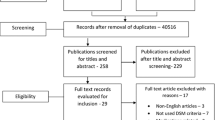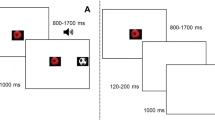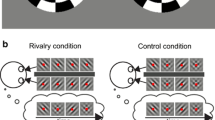Abstract
Children with attention-deficit hyperactivity disorder (ADHD) are impulsive, and that impulsiveness can be measured using a countermanding task. Although the overt behaviors of ADHD attenuate with age, it is not clear how well impulsiveness is controlled in adults with ADHD. We tested ADHD adults with an oculomotor countermanding task. The task included two conditions: on 75% of the trials, participants viewed a central fixation marker and then looked to an eccentric target that appeared simultaneous with the disappearance of the fixation marker; on 25% of the trials, a signal was presented at variable delays after target appearance. The signal instructed subjects to stop, or countermand, an eye movement to the target. A correct movement in this case would be to hold gaze at the central fixation location. We expected ADHD participants to be impulsive in their countermanding performance. Additionally, we expected that a visual stop signal at the central fixation location would assist oculomotor countermanding because the signal is presented in the "stop" location, at fixation. To test whether a central stop signal positively biased countermanding, we used a three types of stop signal to instruct the stop: a central visual marker, a peripheral visual signal, and a non-localized sound. All subjects performed best with the central visual stop signal. Subjects with ADHD were less able to countermand eye movements and were influenced more negatively by the non-central signals. Oculomotor countermanding may be useful for quantifying impulsive dysfunction in adults with ADHD especially if a non-central stop signal is applied.






Similar content being viewed by others
Notes
Anecdotal evidence from pilot work revealed that longer noise bursts for the auditory signal were offensive to participants.
References
American Psychiatric Association (1994) Diagnostic and statistical manual of mental disorders, 4th edn. American Psychiatric Association, Washington DC
Arress KN, Carpenter, RHS (2001) Saccadic countermanding: a comparison of central and peripheral stop signals. Vision Res 41:2645–2651
Barkley RA (1998) Attention-deficit hyperactivity disorder: a handbook for diagnosis and treatment, 2nd edn. Guilford Press, New York
Biederman J, Mick E, Faraone SV (2000) Age-dependent decline of symptoms of attention deficit hyperactivity disorder: impact of remission definition and symptom type. Am J Psychiatry 157:816–818
Brandeis D, van Leeuwen TH, Rubia K, Vitacco D, Steger J, Pascual-Marqui RD, Steinhausen HC (1998) Neuroelectric mapping reveals precursor of stop failures in children with attention deficits. Behav Brain Res 94:111–125
Cabel DWJ, Armstrong IT, Reingold E, Munoz DP (2000) Control of saccadic initiation in a countermanding task using visual and auditory stop signals. Exp Brain Res 133:431–441
Cairney S, Maruff P, Vance A, Barnett R, Luk E, Currie J (2001) Contextual abnormalities of saccadic inhibition in children with attention deficit hyperactivity disorder. Exp Brain Res 141:507–518
Carpenter RHS (1988) Movements of the eyes, 2nd edn. Pion Ltd., London
Carpenter RHS, Williams MLL (1995) Neural computation of log likelihood in control of saccadic eye movements. Nature 377:59–62
Castellanos FX (1997) Toward a pathophysiology of attention-deficit/hyperactivity disorder. Clin Pediatr 36:381–393
Crosbie J, Schachar R (2001) Deficient inhibition as a marker for familial ADHD. Am J Psychiatry 158:1884–1890
De Jong R, Coles MGH, Logan GD, Gratton G (1990) In search of the point of no return: the control of response processes. J Exp Psychol Hum Percept Perform 16:164–182
Everling S, Paré M, Dorris MC, Munoz DP (1998) Comparison of the discharge characteristics of brain stem omnipause neurons and superior colliculus fixation neurons in monkey: implications for control of fixation and saccade behavior. J Neurophysiol 79:511–528
Fuster JM (1997) The prefrontal cortex: anatomy, physiology, and neuropsychology of the frontal lobe, 3rd edn. Lippincott-Raven, New York
Guitton D, Buchtel HA, Douglas RM (1985) Frontal lobe lesions in man cause difficulties in suppressing reflexive glances and in generating goal-directed saccades. Exp Brain Res 58:455–472
Hanes DP, Carpenter RH (1999) Countermanding saccades in humans. Vision Res 39:2777–2791
Hanes DP, Paré M (1998) Neural control of saccade production studied with the countermanding paradigm: superior colliculus. Soc Neurosci Abstr 24:418
Hanes DP, Schall JD (1996) Neural control of voluntary movement initiation. Science 274:427–430
Heathcote A (1996) RTSYS: a DOS application for the analysis of reaction time data. Behav Res Methods Instrum Comput 28:427–445
Hollingsworth DE, McAuliffe SP, Knowlton BJ (2001) Temporal allocation of visual attention in adult attention deficit hyperactivity disorder. J Cogn Neruosci 13:298–305
Kopecz K (1995) Saccadic reaction times in gap overlap paradigms: a model based on integration of intentional and visual information on neural, dynamic fields. Vision Res 35:2911–2925
Kramer AF, Humphrey DG, Larish JG, Logan GD, Strayer DL (1994) Aging and inhibition: beyond a unitary view of inhibitory processing in attention. Psychol Aging 9:491–512
Krauzlis RJ, Basso MA, Wurtz RH (1997) Shared motor error for multiple eye movements. Science 276:1693–1695
Leigh RJ, Zee DS (1999) The neurology of eye movements, 3rd edn. Oxford University Press, Oxford
Lezak MD (1995) Neuropsychological assessment, 3rd edn. Oxford University Press, Oxford
Logan GD, Cowan WG (1984) On the ability to inhibit thought and action: a theory of an act of control. Psychol Rev 91:295–327
Logan GD, Schachar RJ, Tannock R (1997) Impulsivity and inhibitory control. Psychol Sci 8:60–64
Mehta MA, Owen AM, Sahakian BJ, Mavaddat N, Pickard JD, Robbins TW (2000) Methylphenidate enhances working memory by modulating discrete frontal and parietal lobe regions in the human brain. J Neurosci 20:RC65–U13
Meredith MA, Ramoa AS (1998) Intrinsic circuitry of the superior colliculus: pharmacophysiological identification of horizontally oriented inhibitory interneurons. J Neurophysiol 79:1597–1602
Munoz DP, Istvan PJ (1998) Lateral inhibitory interactions in the intermediate layers of the monkey superior colliculus. J Neurophysiol 79:1193–1209
Munoz DP, Wurtz RH (1993a) Fixation cells in monkey superior colliculus. I. Characteristics of cell discharge. J Neurophysiol 70:559–575
Munoz DP, Wurtz RH (1993b) Fixation cells in monkey superior colliculus. II. Reversible activation and deactivation. J Neurophysiol 70:576–589
Munoz DP, Broughton JR, Goldring JE, Armstrong IT (1998) Age-related performance of human subjects on saccadic eye movements tasks. Exp Brain Res 121:391–400
Munoz DP, Hampton K, Moore K, Goldring JE (1999) Control of purposive saccadic eye movements and visual fixation in children with attention-deficit hyperactivity disorder. In: Becker W, Deuel H, Merger T (eds) Current oculomotor research: physiological and psychological aspects. Plenum Publishers, New York
Munoz DP, Armstrong IT, Hampton KA, Moore KD (2003) Altered control of visual fixation and saccadic eye movements in attention-deficit hyperactivity disorder. J Neurophysiol 90:503–514
Nigg JT (1999) The ADHD response-inhibition deficit as measured by the stop task: replication with DSM-IV combined type, extension, and qualification. J Abnorm Child Psychol 27:393–402
Oosterlaan J, Logan GD, Sergeant J (1998) Response inhibition in AD/HD, CD, comorbid AD/HD + CD, anxious, and control children: a meta-analysis of studies with the stop task. J Child Psychol Psychiatry 39:411–425
Osman A, Kornblum S, Meyer DE (1986) The point of no return in choice reaction time: controlled and ballistic stages of response preparation. J Exp Psychol Hum Percept Perform 12:243–258
Pierrot-Deseilligny C, Rosa A, Masmoudi K, Rivaud S, Gaymard B (1991) Saccade deficits after a unilateral lesion affecting the superior colliculus. J Neurol Neurosurg Psychiatry 54:1106–1109
Quay HC (1997) Inhibition and attention deficit hyperactivity disorder. J Abnorm Child Psychol 25:7–13
Rubia K, Overmeyer S, Taylor E, Brammer M, Williams SCR, Simmons A, Bullmore ET (1999) Hypofrontality in attention deficit hyperactivity disorder during higher-order motor control: a study with functional MRI. Am J Psychiatry 1560:891–896
Sachdev P (1999) Attention deficit hyperactivity disorder in adults. Psychol Med 29:507–514
Schachar R, Logan GD (1990) Impulsivity and inhibitory control in normal development and childhood psychopathology. Dev Psychol 26:710–720
Schachar R, Mota VL, Logan GD, Tannock R, Klim P (2000) Confirmation of an inhibitory control deficit in attention-deficit/hyperactivity disorder. J Abnorm Child Psychol 28:227–235
Solanto MB, Abikoff H, Sonuga-Barke E, Schachar R, Logan GD, Wigal T, Hechtman L, Hinshaw S, Turkel E (2001) The ecological validity of delay aversion and response inhibition as measures of impulsivity in AD/HD: a supplement to the NIMH multimodal treatment study of AD/HD. J Abnorm Child Psychol 29:215–228
Stuss DT, Levine B (2002) Adult clinical neuropsychology: lessons from studies of the frontal lobes. Annu Rev Psychol 53:401–433
Swanson J, Castellanos FX, Murias M, LaHoste G, Kennedy J (1998) Cognitive neuroscience of attention deficit hyperactivity disorder and hyperkinetic disorder. Curr Opin Neurobiol 8:263–271
Tannock R (1998) Attention deficit hyperactivity disorder: advances in cognitive, neurobiological, and genetic research. Child Psychol Psychiatry 39:65–69
Trappenberg RP, Dorris MC, Munoz DP, Klein RM (2001) A model of saccade initiation based on the competitive integration of exogenous and endogenous signals in the superior colliculus. J Cogn Neurosci 13:256–271
Vaidya CJ, Austin G, Kirkorian G, Ridlehuber HW, Desmond JE, Glover GH, Gabrieli JDE (1998) Selective effects of methylphenidate in attention deficit hyperactvity disorder: a functional magnetic resonance study. Proc Natl Acad Sci USA 95:14494–14499
Williams BR, Poness JS, Schachar RJ, Logan GD, Tannock R (1999) Development of inhibitory control across the life span. Dev Psychol 35:205–213
Acknowledgements
We thank Dr. Deb Thompson for psychometric testing, and Kim Moore and Karen Hampton for technical support. This work was supported by an EJLB Foundation research scholar grant to DPM. DPM holds a Canada Research Chair in Neuroscience.
Author information
Authors and Affiliations
Corresponding author
Rights and permissions
About this article
Cite this article
Armstrong, I.T., Munoz, D.P. Inhibitory control of eye movements during oculomotor countermanding in adults with attention-deficit hyperactivity disorder. Exp Brain Res 152, 444–452 (2003). https://doi.org/10.1007/s00221-003-1569-3
Received:
Accepted:
Published:
Issue Date:
DOI: https://doi.org/10.1007/s00221-003-1569-3




